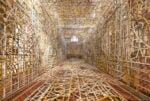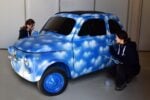Grayson Revoir
.jpg)
Non concede nulla all’estetica Revoir. Non concede nulla all’appagamento sensoriale. Semplicemente devasta l’opera come se fosse una necessità brutale a guidarlo, un istinto primitivo.
Comunicato stampa
Grayson Revoir
La galleria Thomas Brambilla è lieta di annunciare per Sabato 19 Gennaio 2013 l’inaugurazione della mostra personale di Grayson Revoir.
Nato nel 1983 a San Francisco, in California, Grayson Revoir vive e lavora a New York.
Due sono gli artisti di riferimento per Grayson Revoir: Edvard Munch e Günther Uecker.
Per il secondo il riferimento è scontato. Basta guardare i lavori di Grayson che sono tavoli, scale e pannelli di legno trafitti da una moltitudine di viti, chiodi, bulloni, lasciati poi all’aperto sotto la pioggia, e quindi pieni di macchie e striscie di ruggine.
Per il primo invece la vicinanza è data dalla cura da cavallo a cui Revoir, esattamente come Munch, sottopone i suoi lavori. Dopo aver distrutto una scala o un tavolo piuttosto che un pannello di legno, Grayson li abbandona sul soffitto della sua casa di Bushwick aspettando che piova.
Non concede nulla all’estetica Revoir. Non concede nulla all’appagamento sensoriale. Semplicemente devasta l’opera come se fosse una necessità brutale a guidarlo, un istinto primitivo. Una performance fisica di violenza. Uno stupro. Uno stupro necessario per dialogare con la storia dell’arte. Con i buchi di Fontana o con i “fire paintings” di Yves Klein piuttosto che, anche se con tutte le dovute distanze, con il dripping di Jackson Pollock.
Grayson Revoir
Thomas Brambilla gallery is proud to announce on Saturday 19 January 2013 the opening of the solo show of the American artist Grayson Revoir.
Born in 1983 in San Francisco, California, Grayson Revoir lives and works in New York.
There are two artists of reference for Grayson Revoir: Edvard Munch and Günther Uecker.
For the second one, the reference is obvious. Just look at the works of Grayson which are tables, ladders and wooden panels pierced by a multitude of screws, nails, bolts, then left out in the rain, and so full of spots and streaks of rust.
For the first one, instead, the reference is the treatment inflicted to the works by Revoir, just as Munch used to do. After destroying a ladder or a table rather than a wooden panel, Grayson leaves them on the roof of his home in Bushwick waiting for rain.
Revoir gives no concessions to aesthetics. He does not allow anything to gratify the senses. He simply destroys the work with a brutal necessity to guide him, a primitive instinct. A performance of physical violence. A rape. A rape necessary to dialogue with history of art. With the holes by Fontana or the "fire paintings" by Yves Klein rather than, although with all the proper distances, with the dripping of Jackson Pollock.



